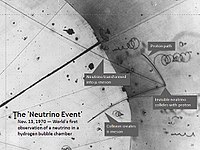
Photo from wikipedia
Thermal MeV neutrino emission from core-collapse supernovae offers a unique opportunity to probe physics beyond the Standard Model in the neutrino sector. The next generation of neutrino experiments, such as… Click to show full abstract
Thermal MeV neutrino emission from core-collapse supernovae offers a unique opportunity to probe physics beyond the Standard Model in the neutrino sector. The next generation of neutrino experiments, such as DUNE and Hyper-Kamiokande, can detect 𝒪(103) and 𝒪(104) neutrinos in the event of a Galactic supernova, respectively. As supernova neutrinos propagate to Earth, they may interact with the local dark matter via hidden mediators and may be delayed with respect to the initial neutrino signal. We show that for sub-MeV dark matter, the presence of dark matter-neutrino interactions may lead to neutrino echoes with significant time delays. The absence or presence of this feature in the light curve of MeV neutrinos from a supernova allows us to probe parameter space that has not been explored by dark matter direct detection experiments.
Journal Title: Journal of Cosmology and Astroparticle Physics
Year Published: 2022
Link to full text (if available)
Share on Social Media: Sign Up to like & get
recommendations!